
Meghalaya is a state in northeast India. Meghalaya was formed on 21 January 1972 by carving out two districts from the state of Assam: (a) the United Khasi Hills and Jaintia Hills and (b) the Garo Hills. The population of Meghalaya as of 2014 is estimated to be 3,211,474. Meghalaya covers an area of approximately 22,429 square kilometres, with a length-to-breadth ratio of about 3:1.
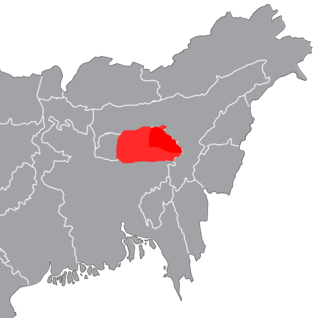
Khasi is an Austroasiatic language with just over a million speakers in north-east India, primarily the Khasi people in the state of Meghalaya. It has associate official status in some districts of this state. The closest relatives of Khasi are the other languages in the Khasic group of the Shillong Plateau; these include Pnar, Lyngngam and War.
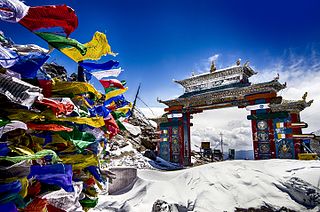
Northeast India (officially the North Eastern Region(NER)) is the easternmost region of India representing both a geographic and political administrative division of the country. It comprises eight states—Arunachal Pradesh, Assam, Manipur, Meghalaya, Mizoram, Nagaland and Tripura (commonly known as the "Seven Sisters"), and the "brother" state Sikkim.

The Khasi people are an ethnic group of Meghalaya in north-eastern India with a significant population in the bordering state of Assam, and in certain parts of Bangladesh. Khasi people form the majority of the population of the eastern part of Meghalaya, that is Khasi Hills, constituting 78.3% of the region's population, and is the state's largest community, with around 48% of the population of Meghalaya. They are among the few Austroasiatic-speaking peoples in South Asia. The Khasi tribe holds the distinction of being one of the few remaining matriarchal tribes of the world. Under the Constitution of India, the Khasis have been granted the status of Scheduled Tribe.

A double-decker bus or double-deck bus is a bus that has two storeys or decks. They are used for mass transport in the United Kingdom, the United States, Canada, New Zealand, Europe, Asia and also in cities such as Sydney; the best-known example is the red London bus, namely the AEC Routemaster.

A simple suspension bridge is a primitive type of bridge in which the deck of the bridge lies on two parallel load-bearing cables that are anchored at either end. They have no towers or piers. The cables follow a shallow downward catenary arc which moves in response to dynamic loads on the bridge deck.

East Khasi Hills is an administrative district in the state of Meghalaya in India. The district headquarters are located at Shillong. The district occupies an area of 2752 km² and has a population of 825,922. As of 2011, it is the most populous district of Meghalaya's 12 districts.
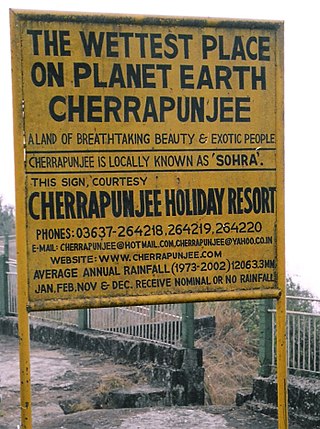
Cherrapunji or Sohra is a sub-divisional town East Khasi Hills district in the Indian state of Meghalaya. It is the traditional capital of ka hima Sohra.

Tree shaping uses living trees and other woody plants as the medium to create structures and art. There are a few different methods used by the various artists to shape their trees, which share a common heritage with other artistic horticultural and agricultural practices, such as pleaching, bonsai, espalier, and topiary, and employing some similar techniques. Most artists use grafting to deliberately induce the inosculation of living trunks, branches, and roots, into artistic designs or functional structures.
The tribal people of Bangladesh are ethnic minorities in Chittagong Hill Tracts (southeastern), Sylhet Division (northeastern), Rajshahi Division (west), and Mymensingh Division (north-central) areas of the country. They are indigenous and the tribal races, total population of ethnic minorities in Bangladesh was estimated to be over 2 million in 2010. They are diverse ethnic communities including Tibeto-Burman, Austric and Dravidian people.
Tirot Sing, also known as U Tirot Sing Syiem, was one of the chiefs of the Khasi people in the early 19th century. He drew his lineage from the Syiemlieh clan. He was Syiem (chief) of Nongkhlaw, part of the Khasi Hills. His surname was Syiemlieh. He was a constitutional head sharing corporate authority with his Council, general representatives of the leading clans within his territory. Tirot Sing declared war and fought against the British for attempts to take over control of the Khasi Hills.
Laitkynsew is a village in the East Khasi Hills district of Meghalaya State, in north-eastern India. It is perhaps best known for its living root bridges. The Umnnoi living root bridge, known locally as Jingkieng Deingjri, which means 'bridge of the rubber tree', is 53 feet long and over 100 years old. The Ka Likai waterfall, near the neighboring village of Nongriat, can best be seen from Laitkynsew, and the monsoon season in autumn is the most impressive time to view it.
Tyrna is a village in the East Khasi Hills district of Meghalaya State, in north-eastern India. A succession of stone steps connect the community with neighboring village of Nongriat, just below the Cherrapunji-Laitkynsew bridle path.
Ka Likai is a waterfall in the East Khasi Hills district of Meghalaya State, in north-eastern India. Its river begins in Rangiirteh and passes by the village of Nongriat, though the waterfall can best be seen from the nearby village of Laitkynsew, and the monsoon season in autumn is the most impressive time to view it. Ka Likai is named for a woman from old-time Rangiirteh by the same name, who threw herself into the falls after discovering that her young child by her first husband, had been killed and dismembered by her second husband and then fed to her by him in a curry. From that time forward the waterfall was called the Fall of Ka Likai.
Dkhar, is a term used by the Khasis to refer to non-Khasi people in Meghalaya. It is non derogatory but some perceived it as derogatory. For Khasis any non-tribal is a dkhar and they address them by that term. Sometimes the word dkhar have been collectively used with the term heathen (Non-believers), as most of the native Khasis are christian, While non-tribals are mainly hindu. In real, the term is mostly used against affluent Bengali Hindu settlers from West Bengal or the Bengali Hindu refugees from erstwhile East Pakistan It is sometimes abbreviated to ′Khar and may also denote a Khasi clan with the same name.

A living root bridge is a type of simple suspension bridge formed of living plant roots by tree shaping. They are common in the North-Eastern part of the Indian state of Meghalaya. They are handmade from the aerial roots of rubber fig trees by the Khasi and Jaiñtia peoples of the mountainous terrain along the southern part of the Shillong Plateau. Most of the bridges grow on steep slopes of subtropical moist broadleaf forest between 50 and 1,150 m above sea level.
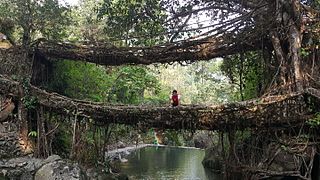
Umshiang Double-Decker Root Bridge is a living root bridge in Meghalya, India. It can be reached via trekking 45 km from Cherapunji. The trek is 6500 steps. There is also a waterfall nearby.
There are various methods of tree shaping. There are strengths and weaknesses to each method as well commendable tree species for each process. Some of these processes are still experimental, whereas others are still in the research stage. These methods use a variety of horticultural and arboricultural techniques to achieve an intended design. Chairs, tables, living spaces and art may be shaped from growing trees. Some techniques used are unique to a particular practice, whereas other techniques are common to all, though the implementation may be for different reasons. These methods usually start with an idea of the intended outcome. Some practitioners start with detailed drawings or designs. Other artists start with what the tree already has. Each method has various levels of involvement from the tree shaper.
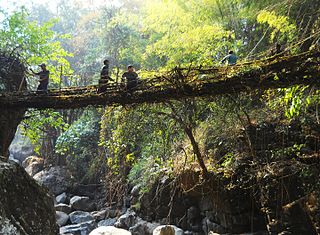
Kongthong, popularly called the Singing Village, is a village and tourist attraction in the East Khasi Hills district of Meghalaya state in the Northeast hilly region of India. Kongthong, India's entry for United Nations World Tourism Organization (UNWTO)'s World's Best Village Contest, is also aiming for the UNESCO Intangible Cultural Heritage status.
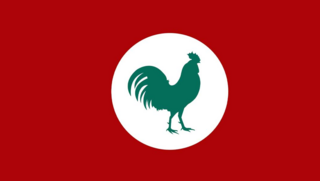
The Seng Khasi movement began in Mawkhar, Shillong on Nov 23rd 1899. The Seng Khasi is a socio cultural organisation formed to protect and preserve the Khasi culture and religion - Niam Khasi - from the forces of change brought by the British. It was founded by 16 young Khasi men under the guidance and mentorship of U Babu Jeebon Roy, an educationist, entrepreneur and advocate of indigenous beliefs and culture of the time. The sixteen founders were concerned about the loss of traditional Khasi culture and values due to the influence of British colonial rule and Christian missionaries.














